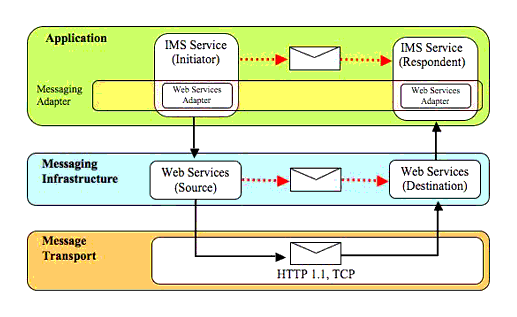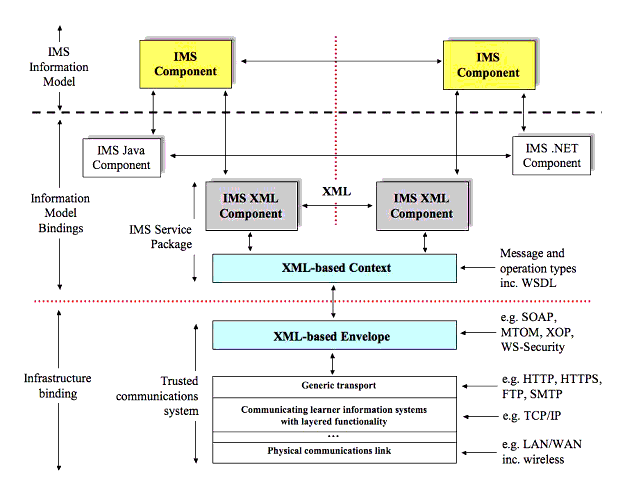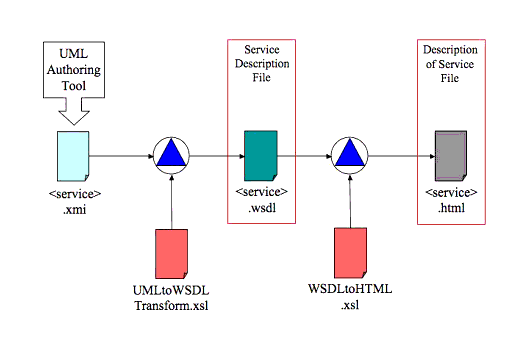
IMS General Web Services Primer
Version 1.0 Final Specification
 |
IMS General Web Services Primer Version 1.0 Final Specification |
Copyright © 2005 IMS Global Learning
Consortium, Inc. All Rights Reserved.
The IMS Logo is a registered trademark of IMS/GLC
Document Name: IMS General Web Services Primer
Revision: 19 December 2005
IPR and Distribution Notices
Recipients of this document are requested to submit, with their comments, notification of any relevant patent claims or other intellectual property rights of which they may be aware that might be infringed by any implementation of the specification set forth in this document, and to provide supporting documentation.
IMS takes no position regarding the validity or scope of any intellectual property or other rights that might be claimed to pertain to the implementation or use of the technology described in this document or the extent to which any license under such rights might or might not be available; neither does it represent that it has made any effort to identify any such rights. Information on IMS's procedures with respect to rights in IMS specifications can be found at the IMS Intellectual Property Rights web page: http://www.imsglobal.org/ipr/imsipr_policyFinal.pdf.
Copyright © 2005 IMS Global Learning Consortium. All Rights Reserved.
If you wish to copy or distribute this document, you must complete a valid Registered User license registration with IMS and receive an email from IMS granting the license to distribute the specification. To register, follow the instructions on the IMS website: http://www.imsglobal.org/specificationdownload.cfm.
This document may be copied and furnished to others by Registered Users who have registered on the IMS website provided that the above copyright notice and this paragraph are included on all such copies. However, this document itself may not be modified in any way, such as by removing the copyright notice or references to IMS, except as needed for the purpose of developing IMS specifications, under the auspices of a chartered IMS project group.
Use of this specification to develop products or services is governed by the license with IMS found on the IMS website: http://www.imsglobal.org/license.html.
The limited permissions granted above are perpetual and will not be revoked by IMS or its successors or assigns.
THIS SPECIFICATION IS BEING OFFERED WITHOUT ANY WARRANTY WHATSOEVER, AND IN PARTICULAR, ANY WARRANTY OF NONINFRINGEMENT IS EXPRESSLY DISCLAIMED. ANY USE OF THIS SPECIFICATION SHALL BE MADE ENTIRELY AT THE IMPLEMENTER'S OWN RISK, AND NEITHER THE CONSORTIUM, NOR ANY OF ITS MEMBERS OR SUBMITTERS, SHALL HAVE ANY LIABILITY WHATSOEVER TO ANY IMPLEMENTER OR THIRD PARTY FOR ANY DAMAGES OF ANY NATURE WHATSOEVER, DIRECTLY OR INDIRECTLY, ARISING FROM THE USE OF THIS SPECIFICATION.
The IMS General Web Services specification promotes interoperability across web service based specification implementations on different software and vendor platforms. The principal component of the IMS General Web Services specification is the Base Profile that identifies a core set of specifications that are to be used to produce a service-oriented architecture using Web Services. It is not a goal of the Base Profile to create a plug-and-play architecture for web services or to guarantee complete interoperability. The IMS General Web Services Base Profile addresses interoperability in the application layer, in particular, the description of behaviors exposed via Web Services. The Base Profile can be extended using one or more of the IMS General Web Services extension profiles. These extension profiles are the Addressing Profile, Security Profile and the Attachments Profile.
From a technical perspective, the IMS General Web Services specification is produced to ensure that all of the services defined by IMS Global Learning Consortium (IMS/GLC) use a common, and thus compatible, message exchange infrastructure. A consequence of this is that the creation of a service specification is focused on the business process and the service methods required which realise that process. This is because the realisation of the service as a Web Service has been reduced to a computer-automated technique. Once a service has been defined using the IMS/GLC specification methodology then the corresponding IMS Binding Auto-generation Toolkit is used to create the corresponding web services binding.
The objective of the IMS General Web Services (GWS) specification is to provide a framework for guiding project teams looking to use web services as part of IMS Global Learning Consortium (IMS/GLC) specification development. A GWS service binding will provide a methodology and an application profile that meets the following criteria:
The IMS General Web Services specification consists of the following documentation:
The bindings for the IMS GWS specification are created using the IMS Binding Auto-generation Toolkit (I-BAT). The I-BAT is used to enable a service specification whose information model is created using the IMS approach to have the corresponding WSDL binding automatically generated from that model. The I-BAT consists of:
Finally, reference implementation source code is supplied to simplify the adoption of the IMS GWS specification. The reference implementation materials consist of:
The structure of the rest of this document is:
The IMS GWS Base Profile [Base, 05] promotes interoperability across web service based specification implementations on different software and vendor platforms. The Base Profile is focused on a core set of web service specifications and the most common problems experienced implementing the identified Web Service specifications. It is not a goal of the General Web Services Base Profile to create a plug-and-play architecture for web services or to guarantee complete interoperability. The General Web Services Base Profile addresses interoperability in the application layer, in particular, the description of behaviors exposed via Web Services. The General Web Services Base Profile assumes the interoperability of the lower layer protocols is sufficient. The information exchange model for the IMS GWS is shown in Figure 2.1.

The salient feature of this model is that the lower level profiles are primarily responsible for defining the 'Messaging Infrastructure'. Once an IMS/GLC service information model has been defined the binding rules are applied to create the messaging choreography. The other advantage of these binding rules is that the corresponding web service adapter for different services have many similar features thereby enabling a common web services adapter framework to be created.
The IMS GWS Base Profile is based upon the Web Services Interoperability Organization (WS-I) Basic Profile v1.1 [WSI, 04a] and the WS-I Simple SOAP Binding Profile v1.0 [WSI, 04b]. The IMS GWS Base Profile is defined in Table 2.1. The only difference between the IMS profile and that of the WS-I Basic Profile is that the Universal Description Discovery & Integration (UDDI) specification is not included in the IMS/GLC profile due to the limited availability of UDDI-based repositories. The WS-I Basic Profile consists of a set of non-proprietary Web Services specifications, along with clarifications and amendments to those specifications that promote interoperability. The WS-I Basic Profile has been selected as the basis for the IMS GWS Base Profile because it is has wide adoption in many different business sectors.
It is recognized that SOAP v1.2 and WSDL v2.0 are available as later versions of the SOAP and WSDL specifications respectively. SOAP v1.2 and WSDL v2.0 will be considered for future revisions.
The IMS GWS Addressing Profile [Address, 05] extends the IMS GWS Base Profile to allow transport-independent end-to-end addressing. The IMS GWS Addressing Profile recommends the usage of the WS-Addressing standard from W3C. The WS-Addressing standard enables a SOAP message to be extended to contain the source of the information, the final destination address, the specific endpoint at the destination and instructions for processing if delivery is not possible. Many other WS-*1 specifications rely upon the usage of WS-Addressing. The IMS GWS Addressing Profile describes how the addressing information is inserted in the SOAP header and how the 'endpoint reference' is defined. The 'endpoint reference' is used to provide an identifier that pinpoints a particular instance of a service. In most cases the 'endpoint reference' is dynamically generated from the properties defined in the associated WSDL file.
The IMS GWS Security Profile [Security, 05] extends the IMS GWS Base Profile to allow the support of a range of secure architectures. The WS-I is developing their Basic Security Profile but this profile is too immature for immediate adoption by IMS/GLC. Therefore, the IMS GWS Security Profile contains only general recommendations and these will be revisited once the WS-I Basic Security Profile has matured. Security for web services, as with any network-oriented information technology, is vital. Web services security builds on existing security standards for confidentiality, integrity, non-repudiation, authentication and authorization at the transport, platform and application level. The key to security is analyzing the potential threats and implementing countermeasures to reduce risk to an acceptable level. Selecting the appropriate countermeasures and defining the acceptable level of risk is best done on an individual basis for each implementation. Securing the network traffic is a simple way to provide message integrity and confidentiality between points. Mechanisms for securing network traffic include Secure Socket layer, Transport Layer Security, Virtual Private Network and IP Security.
The IMS GWS Attachments Profile [Attachments, 05] extends the IMS GWS Base Profile to support the exchange of non-XML information in the SOAP messages. This enables MS Word documents, images, zip files, etc. to be exchanged using SOAP messages. Non-XML information is attached to the SOAP messages using the Message Transmission Optimization Mechanism (MTOM). MTOM combines the transport efficiency of SOAP with Attachments (SWA) and the flexibility of Base64 encoding. WS-I recommends the usage of SWA however SWA is based upon an inefficient MIME encoding technique (as per email) and is incompatible with WS-Security (WS-Security will eventually form the basis of the IMS Security Profile). MTOM uses the XML-binary Optimization Packaging (XOP) mechanism for efficiently placing non-XML content into MIME packages.
From a technical perspective, the IMS GWS specification is produced to ensure that all of the services defined by IMS/GLC use a common, and thus compatible, message exchange infrastructure. A consequence of this is that the creation of a service specification is focused on the business process and the service methods required which realise that process. This is because the realisation of the service as a Web Service has been reduced to a computer-automated technique. Figure 3.1 is a schematic representation of the relationship between an IMS/GLC specification and the IMS GWS.

In Figure 3.1 the key parts of this infrastructure are:
To use the IMS GWS profiles the specification creators must make the following decisions:
The service(s) is created using an abstract representation that is then transformed into the corresponding Web Service binding. All of this process is supported using the IMS specification development tools developed specifically for this need.
The process for creating a WSDL binding for a service that is based upon the IMS GWS Base Profile is shown schematically in Figure 4.1. The steps in the process are:
The XMI file is now used as input to the I-BAT. The XSL file 'UMLtoWSDLTransform.xsl' is applied to the XMI file, using an appropriate XSLT tool (Oxygen is the tool recommended by IMS/GLC) to generate the WSDL files. The XSL files automatically create the full set of WSDL files using a predetermined naming convention for the corresponding directory structure, the name(s) of the services and the communications model. The generation process also creates a validation report text file that can be used to identify any problems that the I-BAT found while creating the binding files. The XSL 'WSDLtoHTML.xsl' is used to generate a HTML document that contains the description of the services defined by the WSDL.

The following points should be noted when using the I-BAT:
The I-BAT is made available to support the development of non-IMS specifications. All of the templates and XSLs are supplied with the toolkit.
| Title |
IMS
General Web Service Services Primer |
| Editor |
Colin
Smythe (IMS) |
| Team Co-Leads |
Cathy
Schroeder (Microsoft Corp.), James Simon (SUN Microsystems
Corp.) |
| Version |
1.0 |
| Version Date |
19
December 2005 |
| Status |
Final Specification |
| Summary |
This
document contains an overview of the IMS General Web Services.
This primer gives an introduction to the set of profiles (Basic
Profile, Addressing Profile, Security Profile and Attachments
Profile). The overview also contains a description of how these
profiles are to be used to support the development of an IMS
specification and how the corresponding Web Services Description
Language bindings are produced. |
| Revision
Information |
19
December 2005 |
| Purpose |
This
document is circulated for public adoption. This document should
be used to introduce the IMS General Web Services
specification. |
| Document Location |
http://www.imsglobal.org/gws/gwsv1p0/imsgws_primerv1p0.html |
| To
register any comments or questions about this specification
please visit:
http://www.imsglobal.org/developers/ims/imsforum/categories.cfm?catid=20 |
The following individuals contributed to the development of this document:
| Version No. | Release Date | Comments |
|---|---|---|
| Final
v1.0 |
19
December 2005 |
This is
the first formal version of the Final Release. |
I
IMS Auto-generation Binding
Tool 1, 2, 3, 4
IMS General Web Services
1, 2, 3, 4, 5, 6, 7, 8, 9, 10
Addressing Profile
1, 2, 3
Attachments Profile
1, 2, 3
Base Profile 1, 2, 3, 4, 5, 6, 7
Security Profile 1, 2, 3
Internet Protocol 1, 2
IP Security 1
P
Protocols
HTTP 1, 2, 3
IP 1, 2, 3
IPSEC 1
SOAP 1, 2, 3, 4, 5
TCP 1, 2
S
Security 1, 2, 3, 4, 5
SOAP 1, 2, 3, 4, 5
SOAP with Attachments 1, 2
T
TCP 1, 2
Transmission Control Protocol
1, 2
Transport Layer Security
1
U
UDDI 1, 2
Unified Modelling Language
1, 2, 3, 4
UML 1, 2, 3
V
Virtual Private Network
1
W
W3C 1, 2
Web Services 1, 2, 3, 4, 5, 6
SOAP 1, 2, 3, 4, 5
WSDL 1, 2, 3, 4, 5, 6, 7
WS-Security 1
Web Services Interoperability
Organization 1,
2, 3
WSDL 1, 2, 3, 4, 5, 6, 7
WS-I
Basic Profile 1
Basic Security Profile
1
Simple SOAP Binding
Profile 1, 2
WS-I Basic Profile 1
WS-I Basic Security Profile
1
WS-I Simple SOAP Binding
Profile 1, 2
WS-Security 1
X
XMI 1, 2, 3
XML 1, 2, 3, 4, 5
XML Schema 1, 2
XML Schema Definition 1
XSD 1, 2, 3
XSLT 1
IMS Global Learning Consortium, Inc.
("IMS/GLC") is publishing the information contained in this
IMS General Web Services Primer ("Specification") for
purposes of scientific, experimental, and scholarly collaboration
only.
IMS/GLC makes no warranty or representation regarding the
accuracy or completeness of the Specification.
This material is provided on an "As Is" and "As Available"
basis.
The Specification is at all times subject to change and revision
without notice.
It is your sole responsibility to evaluate the usefulness,
accuracy, and completeness of the Specification as it relates to
you.
IMS/GLC would appreciate receiving your comments and
suggestions.
Please contact IMS/GLC through our website at http://www.imsglobal.org
Please refer to Document Name: IMS General Web Services
Primer Revision: 19 December 2005